Home » Rocks » Sedimentary Rocks » Conglomerate
Conglomerate
What Is Conglomerate? How Does It Form? What Is It Used For?
Article by: Hobart M. King, PhD, RPG
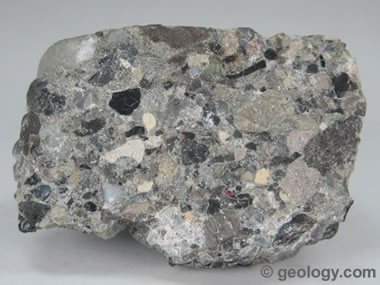
Conglomerate: The specimen shown is about two inches (five centimeters) across. It is made up of chert and limestone clasts bound in a matrix of sand- and clay-size particles.
What is Conglomerate?
Conglomerate is a clastic sedimentary rock made up of rounded clasts that are greater than two millimeters in diameter. The spaces between the clasts are generally filled with sand- and clay-size particles. The rock is bound together by a cement that is usually composed of calcite or quartz.
Table of Contents
 What Is Conglomerate? What Is Conglomerate? Composition Composition Formation Formation Conglomerate vs. Breccia Conglomerate vs. Breccia Uses Uses Puddingstone Puddingstone Conglomerate on Mars Conglomerate on Mars |
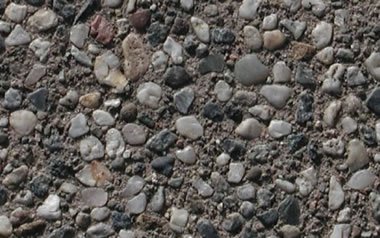
Conglomerate Close-Up: A detailed view of conglomerate showing the pebble-size clasts with sand and smaller size particles filling the spaces between them. The largest pebbles in this view are about ten millimeters across. Image by the United States Geological Survey.
What is the Composition of Conglomerate?
Conglomerate can have a variety of compositions. As a clastic sedimentary rock, it can contain clasts of any rock material or weathering product that is washed downstream or down current.
The rounded clasts of conglomerate can be mineral particles such as quartz or feldspar, or they can be sedimentary, metamorphic, or igneous rock fragments. Clasts of quartzite, sandstone, limestone, granite, basalt, and gneiss are especially common.
The matrix that binds the clasts together can be a mixture of sand, mud, and chemical cement. Common chemical cements are calcite or quartz.
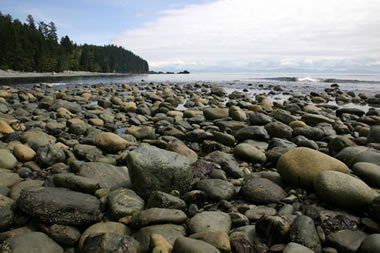
Conglomerate-Forming Environment: A beach where strong waves have deposited rounded, cobble-size rocks. If buried and lithified, these materials might be transformed into a conglomerate. Image copyright iStockphoto / Jason van der Valk.
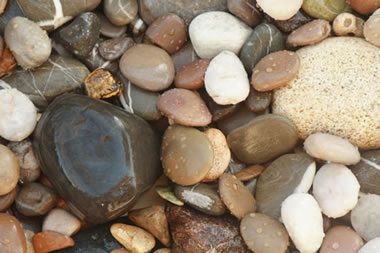
Conglomerate-Size Sediment Clasts: Pebble-size clasts of many compositions deposited together on a beach. Quartz, sandstone, and limestone clasts are all easily recognizable. Largest clast is about two inches (five centimeters) across. Image copyright iStockphoto / Ivan Ivanov.
How Does Conglomerate Form?
Conglomerate forms where sediments of rounded clasts at least two millimeters in diameter accumulate. It takes a strong water current to transport and produce a rounded shape on particles this large. Wind transport is unlikely to produce a conglomerate.
The environment of deposition might be along a swiftly flowing stream or a beach with strong waves. These conditions might only be met during times of extreme flow or wave action. However, it is during these times that much of the Earth's sediments are picked up, moved, and deposited.
To form a conglomerate, there must also be a source of large-size sediment particles somewhere up current. The rounded shape of the clasts reveals that they were tumbled for some distance by running water or moving waves. These conditions are found in streams, lakes, and oceans in many parts of the world.
Conglomerates often begin when a sediment consisting mainly of pebble- and cobble-size clasts is being deposited. The finer-size sand and clay, which fill the spaces between the larger clasts, is often deposited later on top of the large clasts and then sifts down between them to fill the interstitial spaces. After compaction, the precipitation of a chemical cement between the grains will bind the sediment into a rock.

Breccia is a rock that is similar to conglomerate; however, the clasts in breccia are angular in shape rather than rounded like in conglomerate. The shape of the clasts is the only physical difference between conglomerate and breccia. The specimen is about two inches (five centimeters) across.
Conglomerate vs. Breccia
Conglomerate and breccia are similar rocks. They are both made of clasts over two millimeters in diameter. What's the difference between conglomerate and breccia?
The difference is in the shape of the clasts. Conglomerate is made up mostly of subrounded to rounded clasts. However, breccia is made up mostly of subangular to angular clasts.
Sedimentary clasts can be angular or rounded. What determines the difference? They both start out at an outcrop (a location where a rock unit is exposed at Earth's surface). This outcrop is known as the "source area" for the clasts.
In the source area, chemical and physical weathering act upon the rock, causing it to break or disintegrate into smaller pieces. These pieces are usually subangular to angular. If the clasts accumulate near the outcrop and form into a rock, that rock will have angular pieces and be a breccia.
However, if the pieces are transported by a stream or the action of waves, the clasts will be abraded against one another and against other clasts on the bottom of the stream. That abrasion will - over time - cause their angular shapes to become subrounded to rounded. If the rounded clasts are deposited and formed into a rock, that rock with rounded clasts will be a conglomerate.
The difference between conglomerate and breccia is in the transportation history of their clasts.

Red Conglomerate: This photograph shows a portion of a dimension stone slab that was cut from a red conglomerate. The conglomerate is composed of well-rounded clasts of quartz and sedimentary rocks of various sizes and kinds along with a fine-grained matrix. To work well as a dimension stone, this conglomerate would have to be bound tightly with a very competent cement. If competent, this material would make spectacular wall panels, flooring tiles, stair treads, and other architectural elements. Image copyright iStockphoto / Violetastock.
Uses of Conglomerate
Conglomerate has very few commercial uses. Its inability to break cleanly makes it a poor candidate for dimension stone, and its variable composition makes it a rock of unreliable physical strength and durability.
Conglomerate can be crushed to make a fine aggregate that can be used where a low-performance material is suitable. Many conglomerates are colorful and attractive rocks, but they are rarely used as an ornamental stone.
Analysis of conglomerate can sometimes be used as a prospecting tool. For example, most diamond deposits are hosted in kimberlite. If a conglomerate contains clasts of kimberlite, then the source of that kimberlite must be upstream of the location where the kimberlite clast was deposited. That sounds simple, but the kimberlite clast might have been deposited a few million years ago in a different landscape - but people have been successful in using this type of clue to successfully locate a diamond deposit.
In rare instances, conglomerate can be a "fossil placer deposit" containing gold, diamonds, or other valuable minerals. These conglomerates are mined, crushed, and processed as ores.
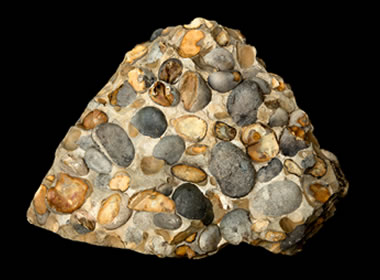
Puddingstone: Puddingstone is a conglomerate composed of clasts that contrast sharply with the rock matrix. This rock in the photo is a specimen of the Hertfordshire puddingstone, from the lower Eocene of the London Basin. It consists of colorful flint pebbles in a white to brown silicate matrix. This type of rock is found at many locations in Hertfordshire County, England. Image by John Cancalosi / Alamy Stock Photo.
Puddingstone Conglomerate
Puddingstone is a nonscientific name for a conglomerate made up of clasts that contrast sharply with the color of the rock's matrix. People in what is today the United Kingdom were the first to use the name. They claim that the rocks reminded them of a "plum pudding". Puddingstones are found in many parts of the world. We have an article with images of puddingstones from France, Canada, India, Maryland (USA), the United Kingdom, and Mars. Learn more about puddingstone here!
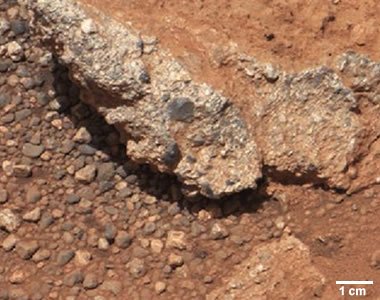
Martian Conglomerate: This image was acquired by NASA's Curiosity rover on the surface of Mars. It shows an outcrop of conglomerate and some pebble-size weathering debris. The round pebbles are too large to have been moved and shaped by wind, thus they had to have been transported a significant distance by water. This photo from September 2012 was the strongest evidence of the existence of water on Mars that had been obtained at that time. See more Earth-like rocks on Mars.
Conglomerate on Mars
In September 2012, NASA's Mars rover Curiosity discovered an outcrop of conglomerate exposed on the surface of Mars. The rounded clasts within the conglomerate provide evidence that a stream or a beach had moved the rocks and tumbled them into rounded pebbles. This conglomerate is one of the most convincing evidences that water once flowed on the surface of Mars (see the accompanying photo).
| More Rocks |
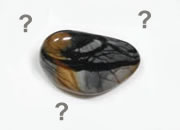 |
Difficult Rocks |
 |
Fossils |
 |
Tumbled Stones |
 |
Geodes |
 |
The Rock Used to Make Beer |
 |
Fluorescent Minerals |
 |
Rock, Mineral and Fossil Collections. |
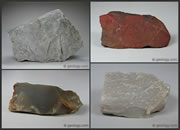 |
Flint, Chert, and Jasper |

Find Other Topics on Geology.com:

|

| ||

|

| ||

|

| ||

|

|
